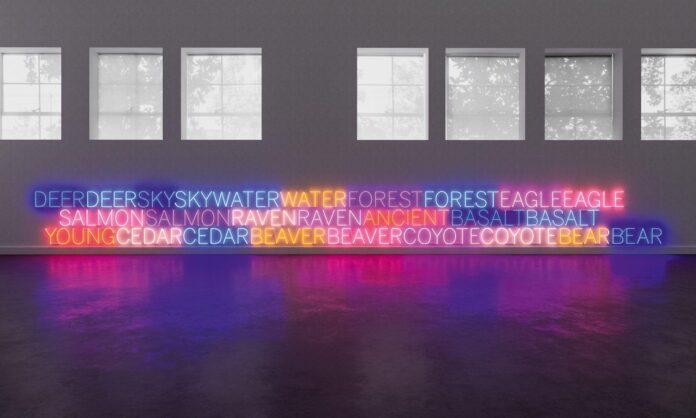Discerning curatorial trends among The Armory Show’s more than 220 exhibitors can be challenging, but this year one current is especially clear: the fair, its galleries and organisers are foregrounding the work of Indigenous artists. This negotiation of Native identity in a commercial context begs some questions, including: what does it mean to decolonise an art fair, and can it realistically be done?
Candice Hopkins—a Carcross/Tagish First Nation citizen who is the director and chief curator of Forge Project in upstate New York—is curating The Armory Show’s Focus section, which this year features 31 galleries showing solo and two-artist presentations. Her vision for the section “is less about representing artists who I feel haven’t been represented on this kind of stage before, and it’s actually a deeper exploration into thinking about material inheritances”, she says. “That can be practices and tools and techniques that are passed down over generations. That can be regional or place-based, because materials and their histories tell stories.”
She highlights the work of Eric-Paul Riege—a Diné textile artist and weaver based in Gallup, New Mexico, who is showing with Minneapolis-based Bockley Gallery—as typical of her approach to the fair. “He works with many generations of weavers in his family, and he taught himself to weave based on a weaving that was made by his grandmother that’s now part of the regalia that he makes,” Hopkins says. “He makes these giant, oversized soft sculptures, many of them modelled after what you would see today as contemporary Navajo jewellery. They’ve increasingly become animated, so they make sound and he performs in relation to them.” Riege’s presentation at the fair will include performances.
Hopkins’s section spans emerging artists, like Riege, and prominent figures like Tlingit and Unangax̂ artist Nicholas Galanin (showing with New York’s Peter Blum Gallery), Seneca artist Marie Watt and Choctaw-Cherokee artist Jeffrey Gibson, who was recently selected to represent the US at the 2024 Venice Biennale. (Watt and Gibson are showing with New York gallery Marc Straus.)

A sculpture by Lawrence Paul Yuxweluptun, a Cowichan/Syilx First Nations artist Courtesy of Macaulay & Co. Fine Art
Vancouver-based gallery Macaulay & Co. Fine Art is bringing a more historically tinged solo presentation of works by the Cowichan/Syilx First Nations artist Lawrence Paul Yuxweluptun, including a painting featured in the National Gallery of Canada’s landmark 1992 exhibition of contemporary Indigenous art, Land Spirit Power. That was “the first time that the National Gallery of Canada had ever done an exhibition even acknowledging contemporary Native art, and it was after a lot of activism from Native artists”, Hopkins says. “It’s an opportunity to see a piece of history.”
Emphasis on history as a timely consideration is also on the minds of gallerists at the fair. “There’s been an uptick in interest in Indigenous work over the past five years,” says Dave Kimelberg, a member of the Seneca Nation and founder of K Art Gallery in Buffalo, New York, which champions works by Native American, First Nations and Indigenous artists. The gallery is showing at Armory for the second time, focusing on the work of G. Peter Jemison, a member of the Seneca Nation’s Heron clan. The stand will span works from the 1960s to today.
“Peter has had an amazing and varied career, and it’s so exciting that we get to bring him to an Armory audience,” Kimelberg says. “Our agenda is to get Indigenous artists into the contemporary art market.”

























